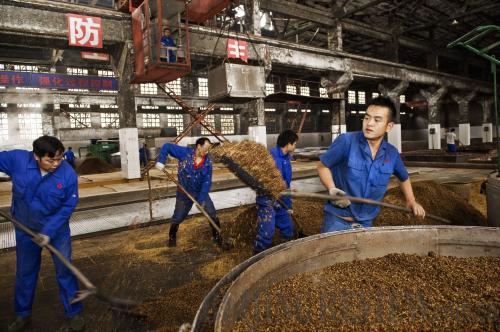|
 |
|
FOR SAFE LIQUORS: Workers at a Jiugui Liquor factory sort grain used for the distillation of baijiu. The company announced in December 2012 that it had removed excess toxic plasticizers from its production lines (XIE CHANGGUI) |
Such prosperity drove some producers to cut corners by adding non-distilled alcohol to their liquors. In 1996, 192 people in Qujing, Yunnan Province were poisoned after drinking liquors blended with formaldehyde, with 35 lives being claimed; in January 1998, 27 people in Shuozhou, Shanxi Province were killed after drinking liquors blended with methanol. The two tragedies shocked the country, bringing an end to the liquor industry's first golden era. The annual output of the industry tumbled, reaching a low point in 2004, less than half of its highest output. Many breweries were sold or closed down.
When the industry was suffering a nadir, some high-end liquor producers re-organized. The five biggest Chinese liquor makers—Moutai, Wuliangye, Luzhoulaojiao, Yanghe and Fenjiu—controlled 20.4 percent of the market share in 2003, up from a 14.2-percent share in 2000.
Beginning that year, China's liquor industry entered into its second golden era and saw high growth once again, particularly from 2007 to 2010. Moutai even created a ceiling to curb soaring prices.
According to figures from the Ministry of Industry and Information Technology, in 2011 China's liquor output soared by nearly 50 percent compared to 1997 and liquor producers with an annual sales revenue of more than 5 million yuan ($796,178) saw their net profits increase 51.91 percent.
In the first three quarters of 2012 the liquor industry maintained high profit growth, and the stocks of liquor makers became "stars" in the eyes of investors. But after Jiugui's toxic plasticizer scandal, liquor stock prices fell dramatically. After a nearly decade of rapid development since 2003, the industry is once again in a slump.
"Similar to the reason for the end of the last golden era, the slump was caused by blended liquors. But this time, there is a toxic element to the story." Li, the liquor salesperson, said.
"After rapid development, the industry is in a restructuring period," said Zhu Zhongyu, Deputy General Manager of Wuliangye Group, at a distributors conference held in December 2012.
Furthermore, according to a report by Northeast Securities Co. Ltd., liquor makers feverishly expanded production during the decade of fast growth, leading to a present-day excess capacity.
No huge losses
On January 5, Moutai announced that six distributors would be punished for selling Moutai at lower than permitted prices.
At Moutai's distributors conference held in December 2012, the group insisted that the retail price of Moutai liquor should not drop lower than 1,519 yuan ($242) a bottle and bulk purchase price should be no less than 1,400 yuan ($223) a bottle. Distributors have defied Moutai's requests and are selling below minimum-set prices. Issuing minimum required prices is in contrast to Moutai's imposed price ceiling five years ago.
Wuliangye has also issued measures to stabilize liquor prices recently. According to the group, it will reduce the output of a sub-brand and will raise the prices of ordinary Wuliangye liquors by 10 percent in February.
It is hard to tell whether these measures will work since in market competition companies alone cannot decide prices.
A report by Haitong Securities Co. Ltd. shows growth in the liquor industry will definitely slow down in 2013, though it will not witness contraction.
Under the expectation of lower price hikes, liquor producers can maintain profit growth by expanding output and changing product structures. In the first quarter of 2013, some liquor producers are still likely to maintain a 20-30 percent growth in sales revenue.
A report by icandata.com, an industrial research website, says that 2013 will be a time for liquor makers to regroup and re-organize, a process that could be driven by foreign capital. The toxic plasticizer scandal may cause the bankruptcy of some liquor companies, thereby creating opportunities for foreign capital to enter the industry.
Email us at: lanxinzhen@bjreview.com | 